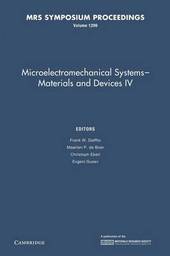
|
Microelectromechanical Systems - Materials and Devices IV: Volume 1299
Paperback / softback
Main Details
| Title |
Microelectromechanical Systems - Materials and Devices IV: Volume 1299
|
| Authors and Contributors |
Edited by Frank W. DelRio
|
|
Edited by Maarten P. de Boer
|
|
Edited by Christoph Eberl
|
|
Edited by Evgeni Gusev
|
| Series | MRS Proceedings |
|---|
| Physical Properties |
| Format:Paperback / softback | | Pages:220 | | Dimensions(mm): Height 229,Width 152 |
|
| Category/Genre | Materials science
Electronics engineering |
|---|
| ISBN/Barcode |
9781107406834
|
| Classifications | Dewey:621.381 |
|---|
| Audience | | Postgraduate, Research & Scholarly | | Professional & Vocational | |
|---|
| Illustrations |
12 Tables, unspecified; 36 Halftones, unspecified; 107 Line drawings, unspecified
|
|
Publishing Details |
| Publisher |
Cambridge University Press
|
| Imprint |
Cambridge University Press
|
| Publication Date |
5 June 2014 |
| Publication Country |
United Kingdom
|
Description
Symposium S, 'Microelectromechanical Systems - Materials and Devices IV', held November 29-December 3 at the 2010 MRS Fall Meeting in Boston, Massachusetts, focused on micro- and nanoelectromechanical systems (MEMS/NEMS), technologies which were spawned from the fabrication and integration of small-scale mechanical, electrical, thermal, magnetic, fluidic and optical sensors and actuators with micro-electronic components. MEMS and NEMS have enabled performance enhancements and manufacturing cost reductions in a number of applications, including optical displays, acceleration sensing, radio-frequency switching, drug delivery, chemical detection and power generation and storage. Although originally based on silicon microelectronics, the reach of MEMS and NEMS has extended well beyond traditional engineering materials and now includes nanomaterials (nanotubes, nanowires, nanoparticles), smart materials (piezoelectric and ferroelectric materials, shape memory alloys, pH-sensitive polymers), metamaterials and biomaterials (ceramic, metallic, polymeric, composite-based implant materials). While these new materials provide more freedom with regards to the design space of MEMS and NEMS, they also introduce a number of new fabrication and characterization challenges not previously encountered with silicon-based technology.
|